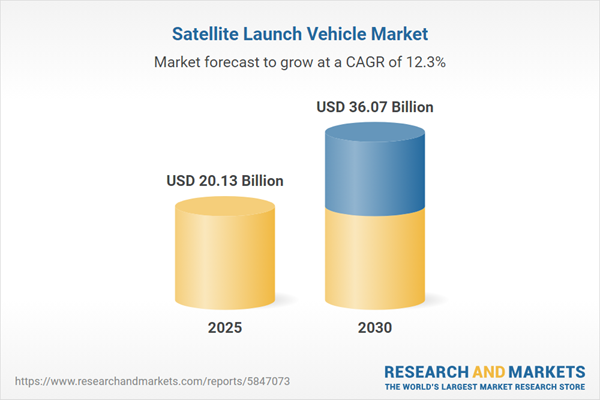Speak directly to the analyst to clarify any post sales queries you may have.
The satellite launch vehicle market is rapidly transforming as the industry embraces innovative propulsion technologies and digital engineering to meet evolving mission demands. Senior leaders must understand shifting landscapes and emerging strategic imperatives to maintain relevance and achieve operational success.
Market Snapshot: Satellite Launch Vehicle Market Overview
The satellite launch vehicle market grew from USD 17.97 billion in 2024 to USD 20.13 billion in 2025. It is on a path to reach USD 36.07 billion by 2030, with an anticipated CAGR of 12.31%. This robust growth is fueled by significant private sector innovation, new business models, and responsive supply chain strategies. Markets in the Americas drive development through both established providers and nimble entrants, while Asia-Pacific and Europe, Middle East, and Africa expand capabilities through partnerships and domestic investment.
Scope & Segmentation
This report delivers in-depth analysis and trend forecasting across critical segments and regions within the satellite launch vehicle ecosystem. Coverage includes all key players and innovation centers shaping the market landscape.
- Vehicle Type: Medium and heavy-lift launch vehicles (500-2,500 kg and above 2,500 kg), small satellite launch vehicles (under 500 kg and up to 2,500 kg).
- Launch Category: Expendable single-use vehicles and reusable systems.
- Launch Platform: Air launch systems, ground-based solutions, sea-based platforms.
- Orbit Type: Beyond Earth orbit, geostationary, low Earth, and medium Earth missions.
- Payload: Segments for loads under 500 kg, between 500–2,500 kg, and above 2,500 kg.
- Stage: Multi-stage and single-stage architectures.
- Application: Commercial and military satellite launches.
- Region: Americas (with detail on North America and Latin America), Europe, Middle East, and Africa (EMEA) segmented by country, and Asia-Pacific (covering China, India, Japan, Australia, South Korea, and several Southeast Asian countries).
- Key Companies: Includes established launch leaders and emerging disruptors such as Blue Origin, ArianeGroup, SpaceX, Indian Space Research Organisation, Rocket Lab, Northrop Grumman, United Launch Alliance, and a diverse set of regional players, contractors, and public agencies.
Key Takeaways: Strategic Insights for Senior Leaders
- Advances in propulsion such as reusable boosters and electric upper stages are transforming cost structures and setting new reliability benchmarks.
- Digital engineering, additive manufacturing, and AI-driven tools are accelerating development cycles, reducing barriers for new entrants, and forcing incumbents to innovate.
- Dedicated small-satellite launchers and modular vehicle architectures align with the surge in microsatellite constellations, enabling rapid and flexible deployment strategies.
- Strategic alliances, mergers, and vertical integration are becoming critical as companies seek streamlined operations and global reach.
- Compliance with evolving regulatory and export control frameworks is essential, especially in light of shifting geopolitical priorities and export control measures.
- Regional diversification of launch infrastructure underscores the value of resilience and autonomy in mission planning and execution.
Tariff Impact: Navigating Post-2025 Trade Shifts
Revised United States tariffs implemented in 2025 have increased supply chain complexity for satellite launch vehicle components. Senior executives are responding with strategies including nearshoring, reshoring, and alternative regional sourcing to manage risk and control costs. These shifts influence certification processes, contractual frameworks, and policy engagements as organizations seek to harmonize standards and reduce disruptive trade impacts.
Methodology & Data Sources
The analysis is built on a mix of primary interviews, industry literature, and proprietary quantitative models. Data collection spans executive insights, technical publications, and publicly available filings. Scenario analysis and cross-validation with subject matter experts ensure accurate, actionable findings grounded in current market realities.
Why This Report Matters
- Enables investment and partnership decisions through authoritative analysis of segmentation, technology, and regulatory drivers.
- Equips market leaders to benchmark strategies and respond decisively to evolving competitive threats and supply chain challenges.
- Delivers transparent, peer-reviewed methodology aligning insights with operational and strategic objectives.
Conclusion
The satellite launch vehicle market’s evolution requires strategic agility and technological foresight. This report provides a clear framework for informed decision-making and sustained leadership as industry transformation accelerates.
Additional Product Information:
- Purchase of this report includes 1 year online access with quarterly updates.
- This report can be updated on request. Please contact our Customer Experience team using the Ask a Question widget on our website.
Table of Contents
3. Executive Summary
4. Market Overview
7. Cumulative Impact of Artificial Intelligence 2025
Companies Mentioned
The companies profiled in this Satellite Launch Vehicle market report include:- ABL Space Systems
- Aevum, Inc.
- Agnikul Cosmos Private Limited
- ArianeGroup
- Astra Space, Inc.
- B2Space Ltd.
- Blue Origin Enterprises, L.P.
- bluShift Aerospace, Inc.
- C6 Launch Systems Inc.
- Celestia Aerospace
- China Aerospace Science and Technology Corporation
- CubeCab
- Dawn Aerospace Limited
- E'Prime Aerospace Corporation
- Firefly Aerospace, Inc.
- IHI Aerospace Co., Ltd.
- Indian Space Research Organisation
- Interorbital Systems
- Isar Aerospace SE
- Israel Aerospace Industries Ltd.
- Japan Aerospace Exploration Agency
- Kelly Space & Technology, Inc.
- Lockheed Martin Corporation
- Mitsubishi Heavy Industries, Ltd.
- Northrop Grumman Corporation
- Rocket Lab USA, Inc.
- Skyroot Aerospace Private Limited
- Space Exploration Technologies Corp.
- United Launch Alliance, LLC
- Centre national d'études spatiales
- Gilmour Space Technologies
- Relativity Space Inc.
- Orbital Express Launch Limited
- The European Space Agency
- National Aeronautics and Space Administration
Table Information
| Report Attribute | Details |
|---|---|
| No. of Pages | 188 |
| Published | November 2025 |
| Forecast Period | 2025 - 2030 |
| Estimated Market Value ( USD | $ 20.13 Billion |
| Forecasted Market Value ( USD | $ 36.07 Billion |
| Compound Annual Growth Rate | 12.3% |
| Regions Covered | Global |
| No. of Companies Mentioned | 36 |









